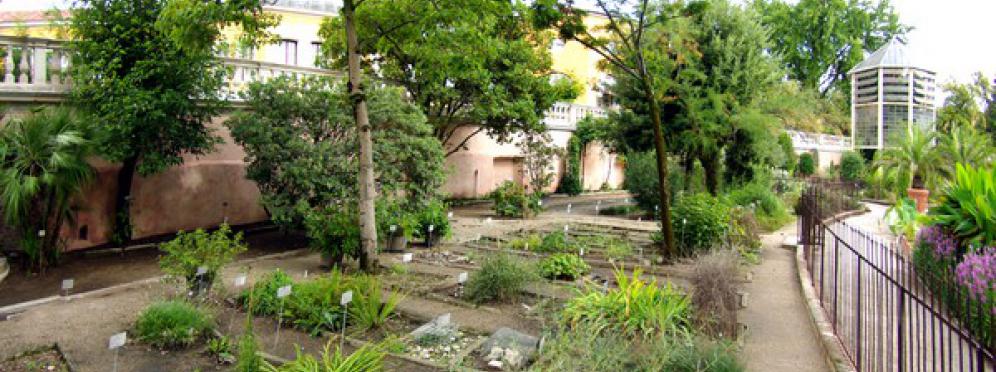Plants of the Euganean Hills and Rare Plants
These two sectors are next to each other along the wall between the south gate and the pools with aquatic plants.

These two sectors are next to each other along the wall between the south gate and the pools with aquatic plants. They play one of the fundamental roles of botanical gardens, i.e., to make the public aware of typical local species, and to collect, preserve and study endangered ones. Dramatic numbers of animals and plants have become extinct in recent years. European and international botanical Gardens have joined forces to preserve the germ plasm of endangered plants, thus ensuring the maintenance of biodiversity.
The sector hosting the most important species of the Euganean Hills is next to the wall between the west and south gates, near the Magnolia quarter and in front of the poisonous plant collection.
The Euganean Hills are a chain of hills rising in the Veneto plain south-west of Padova, and they rise between 300 and 500 metres a.s.l. Their complex geomorphological history, which witnessed the combination of sedimentary rock and volcanic material, has enabled the colonisation of interesting and various flora, so that striking and/or new species for the Euganean and Veneto areas may still be found. The collection of the Garden provides visitors with an overall view of this particular environment.
This sector hosts various typical Mediterranean species, oaks with persistent leaves, such as evergreen oak (Quercus ilex L.), and also deciduous species, like downy oak (Quercus pubescens Willd.), strawberry tree (Arbutus unedo L.) and tree heath (Erica arborea L.), the stout, incombustible underground roots of which are used to produce briarwood pipes. There is also a Spanish broom (Spartium junceum L.), with cylindrical, leafless branches that are shed immediately after its yellow, fragrant flowers and erect, scythe-shaped pods are produced. The Italian poet Leopardi was inspired by brooms due to their ability to colonise bare, inhospitable environments, as often happens in the abandoned caves of the Euganean Hills. Other typical plants of the Euganean Hills are Judas tree (Cercis siliquastrum L.), rock rose (Cistus salvifolius L.) and dittany (Dictamnus albus L.).
This area also contains interesting exotic species, which are not native to Italy, but that here have found a favourable environment, such as dwarf prickly pear [Opuntia compressa (Salisb.) Mcbride], which has lived on siliceous substrates for over 500 years, and Opuntia stricta (Haw.) Haw., which has extensively spread since the 1970s, even to the detriment of the former species.
The sector containing the collection of rare and endangered plants is between the west gate and the pool with aquatic plants, near the ginkgo quarter. The grown species are rare and/or endangered in the Veneto region for reasons related to their genetic heritage, because they live in particular soil, or at the margins of their distribution areas, but particularly because man has destroyed their environment by means of deforestation, reclamation of land, and abandonment of traditional methods of cultivation. The best-known species is probably the Paduan rue (Haplophyllum patavinum (L.) Don fil.), the only species bearing the name of Padova and at present endangered due to the progressive reduction of its environment. New, extensive agricultural techniques have introduced pesticides, fertilisers, and uncontrolled new species from foreign countries, causing genetic and environmental pollution of water, soil and air. The conservation of endangered species now intends to preserve both the biodiversity of all species of an ecosystem and the ecosystem itself which gives rise to a varied landscape. Conservation is carried out by creating protected parks and areas (in situ conservation), but also by collecting the genes of single species (germ plasm) in sperm banks, with a view to their future redistribution in the natural environment. Padua Botanical Garden also contributes to the conservation of biodiversity through the ex situ preservation of the germ plasm of rare species. In the Veneto, there are several reasons why many species risk extinction, e.g., their habitats are gradually disappearing (as for Paduan rue) or they are polluted (many freshwater species), because ancient balances between nature and the proper management of green areas are disturbed (as for species with punctiform distribution), or because they are indiscriminately picked up by humans for food. Among these, there is the wild asparagus, a general word indicating various species of the genera Ruscus (butcher's broom), Asparagus, Clematis and Humulus (hop shoot). Others species are used for therapeutic purposes, or as ornamentals, such as lilies (Lilium bulbiferum L., L. martagon L., L. carniolicum Bernh.), peonies (Paeonia officinalis L.), many orchids, narcissus, etc.. Other rare species of the Veneto, perhaps less well-known, are thrift (Armeria helodes Martini & Poldini), Moltkia suffruticosa (L.) Brand and Gypsophila papillosa Porta.






